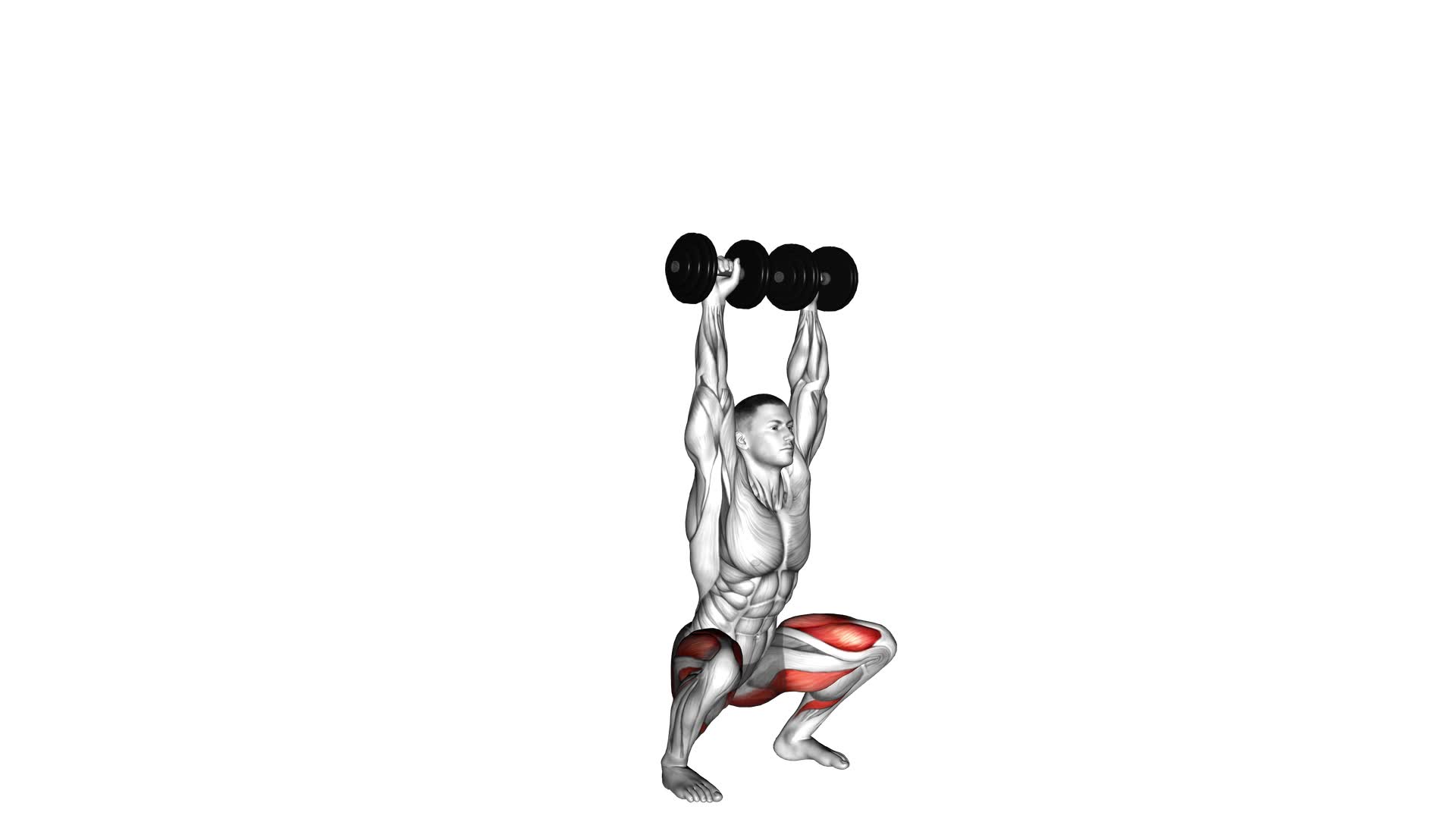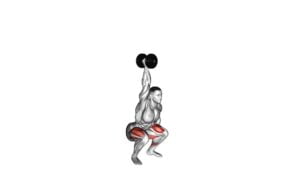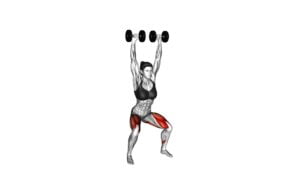Dumbbell Overhead Squat – Video Exercise Guide & Tips

In this video exercise guide, you'll learn all about the dumbbell overhead squat. This powerful exercise offers a range of benefits, from strengthening your lower body to improving your overall stability and mobility.
Watch This Exercise Video
You'll discover the proper form and technique to maximize your results and avoid common mistakes. Plus, we'll share tips for increasing the intensity and modifications to suit different fitness levels.
Get ready to take your workout to the next level with this dynamic move. Let's dive in!
Key Takeaways
- The dumbbell overhead squat strengthens multiple muscle groups simultaneously.
- Proper form and technique are important to maintain throughout the exercise.
- Common mistakes to avoid include leaning too far forward, allowing knees to cave inward, and using weights that are too heavy.
- Tips for increasing intensity include progressive overload techniques, incorporating supersets, increasing repetitions, slowing down the tempo, and using a stability ball.
Benefits of the Dumbbell Overhead Squat
One of the benefits of performing the Dumbbell Overhead Squat is that it helps to strengthen multiple muscle groups simultaneously. This exercise is great for improving core strength and increasing shoulder mobility. By holding the dumbbells overhead while squatting, you engage your core muscles to maintain balance and stability. This not only strengthens your abdominal muscles but also targets the muscles in your lower back and hips.
Additionally, the overhead position of the dumbbells requires your shoulder muscles to work harder, resulting in increased shoulder mobility. This exercise can help improve your range of motion and flexibility in the shoulder joint.
Strengthening your core is essential for overall stability and balance in daily activities and sports. A strong core helps to support your spine and prevent injuries. By incorporating the Dumbbell Overhead Squat into your workout routine, you can effectively target your core muscles and improve their strength. Furthermore, increased shoulder mobility is beneficial for various upper body movements, such as lifting objects overhead or reaching for things.
Proper Form and Technique
To perform the Dumbbell Overhead Squat with proper form and technique, start by gripping the dumbbells firmly and positioning them overhead.
Here are some key points to keep in mind:
- Maintain a neutral spine throughout the exercise, with your chest up and shoulders back.
- Engage your core muscles to stabilize your body as you lower into the squat position.
- Keep your knees aligned with your toes and lower yourself down until your thighs are parallel to the ground.
- As you rise back up, push through your heels and squeeze your glutes to return to the starting position.
- Breathe steadily throughout the movement, inhaling as you lower down and exhaling as you rise up.
There are a few common misconceptions about the Dumbbell Overhead Squat. Some people believe that you need to have a lot of upper body strength to perform this exercise, but it can actually be modified to suit different fitness levels. Additionally, there are variations and progressions you can incorporate to challenge yourself and continue progressing.
Common Mistakes to Avoid
Avoiding common mistakes in the Dumbbell Overhead Squat is crucial for maximizing results and preventing injury. Proper technique is essential to ensure that you're engaging the correct muscles and avoiding unnecessary strain.
One common mistake to watch out for is leaning too far forward during the squat. This can put excessive pressure on your lower back and potentially lead to injury. To avoid this, focus on keeping your chest lifted and your core engaged throughout the movement.
Another mistake is allowing your knees to cave inward. This can put stress on your knee joints and increase the risk of injury. To prevent this, make sure to actively push your knees outwards throughout the squat.
Lastly, avoid using weights that are too heavy for you. This can compromise your form and increase the risk of injury. Start with lighter weights and gradually increase as you become more comfortable and confident in your technique.
Tips for Increasing Intensity
To increase the intensity of the Dumbbell Overhead Squat, focus on incorporating these tips into your workout routine:
- Progressive overload techniques: Gradually increase the weight of the dumbbells you use for the overhead squat. This will challenge your muscles and help them grow stronger over time.
- Incorporating supersets for added challenge: Pair the dumbbell overhead squat with another exercise, such as lunges or push-ups, to create a superset. This will keep your heart rate up and provide a more intense workout.
- Increase the number of repetitions: Instead of performing the standard 8-12 reps, try increasing the number to 15-20. This will fatigue your muscles and make the exercise more challenging.
- Slow down the tempo: Focus on performing the squat in a slow and controlled manner. This will increase the time under tension for your muscles, leading to greater strength gains.
- Use a stability ball: Instead of using dumbbells, try performing the overhead squat while balancing on a stability ball. This will engage your core muscles even more and add an extra level of difficulty.
Incorporating these tips into your dumbbell overhead squat routine will help you increase the intensity of your workout and continue to challenge your muscles. Remember to listen to your body and gradually progress as you get stronger.
Modifications for Different Fitness Levels
For different fitness levels, you can modify the dumbbell overhead squat to suit your abilities and goals. Beginners can start by performing the exercise without weights to focus on mastering the movement and building strength. This modification allows you to work on your squat form and stability without the added challenge of holding dumbbells overhead. As you become more comfortable and confident, you can gradually increase the intensity by incorporating light dumbbells or kettlebells. Holding a lighter weight in each hand will add resistance to the squat, making it more challenging for your muscles.
For advanced modifications, you can use heavier dumbbells or kettlebells to increase the difficulty of the exercise. This will further engage your muscles and enhance strength and stability. Additionally, you can try performing the dumbbell overhead squat on an unstable surface, such as a Bosu ball or a foam pad. This will require greater core activation and balance, making the exercise even more challenging.
Frequently Asked Questions
How Many Calories Does the Dumbbell Overhead Squat Burn?
The dumbbell overhead squat is a challenging exercise that can help you burn calories. By incorporating both your upper and lower body, it engages multiple muscle groups and increases your heart rate, leading to calorie burn.
This exercise also has several benefits, such as improving strength, stability, and mobility. To perform it correctly, you need to maintain proper form and technique.
Now, let's dive into the specifics of the dumbbell overhead squat benefits and technique.
Can the Dumbbell Overhead Squat Help Improve Flexibility?
The dumbbell overhead squat is a great exercise for improving mobility and flexibility. By incorporating this exercise into your routine, you can reap the benefits of overhead squats, such as increased range of motion in your shoulders, hips, and ankles.
This exercise targets multiple muscle groups and requires stability and balance, which can help enhance your overall flexibility.
Is It Safe to Perform the Dumbbell Overhead Squat With a Pre-Existing Shoulder Injury?
If you have a pre-existing shoulder injury, you need to take precautions when performing the dumbbell overhead squat. It's important to modify the exercise to avoid aggravating your injury.
Be mindful of your range of motion and the weight you use. Start with lighter dumbbells and gradually increase as your shoulder strength improves.
Listen to your body and stop if you feel any pain or discomfort. Consulting with a healthcare professional or a certified trainer would be wise for personalized guidance.
How Often Should the Dumbbell Overhead Squat Be Included in a Workout Routine?
When it comes to the dumbbell overhead squat, you might be wondering how often you should include it in your workout routine.
Well, the frequency of the dumbbell overhead squat depends on your fitness goals and abilities. However, incorporating it at least once or twice a week can be beneficial.
This exercise targets multiple muscle groups, improves core strength and stability, and enhances overall body coordination.
Are There Any Alternatives to the Dumbbell Overhead Squat for Individuals With Limited Mobility?
If you have limited mobility and are looking for alternative exercises to the dumbbell overhead squat, there are several options you can try.
One modification is to perform the squat without the dumbbells, focusing on maintaining proper form and range of motion.
Another option is to use a resistance band or cable machine to provide support and assistance during the squat.
These modifications can help you work on your lower body strength while accommodating your mobility limitations.
Conclusion
The dumbbell overhead squat is a challenging exercise that offers numerous benefits for your overall fitness. By engaging multiple muscle groups, it helps improve strength, stability, and mobility.
However, it's important to maintain proper form and technique to avoid common mistakes and prevent injuries. To increase intensity, you can use heavier dumbbells or add variations to the exercise.
Remember to modify the workout according to your fitness level for optimal results.

Author
Years ago, the spark of my life’s passion ignited in my mind the moment I stepped into the local gym for the first time. The inaugural bead of perspiration, the initial endeavor, the very first surge of endorphins, and a sense of pride that washed over me post-workout marked the beginning of my deep-seated interest in strength sports, fitness, and sports nutrition. This very curiosity blossomed rapidly into a profound fascination, propelling me to earn a Master’s degree in Physical Education from the Academy of Physical Education in Krakow, followed by a Sports Manager diploma from the Jagiellonian University. My journey of growth led me to gain more specialized qualifications, such as being a certified personal trainer with a focus on sports dietetics, a lifeguard, and an instructor for wellness and corrective gymnastics. Theoretical knowledge paired seamlessly with practical experience, reinforcing my belief that the transformation of individuals under my guidance was also a reflection of my personal growth. This belief holds true even today. Each day, I strive to push the boundaries and explore new realms. These realms gently elevate me to greater heights. The unique combination of passion for my field and the continuous quest for growth fuels my drive to break new ground.







